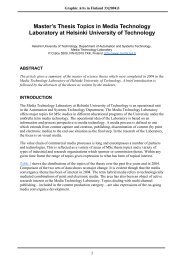Client-Side Storage in Web Applications
Client-Side Storage in Web Applications
Client-Side Storage in Web Applications
Create successful ePaper yourself
Turn your PDF publications into a flip-book with our unique Google optimized e-Paper software.
<strong>Client</strong>-<strong>Side</strong> <strong>Storage</strong> <strong>in</strong> <strong>Web</strong> <strong>Applications</strong>Markku La<strong>in</strong>eDepartment of Media Technology, Aalto UniversityP.O. Box 15500, FI-00076 Aalto, F<strong>in</strong>landmarkku.la<strong>in</strong>e@aalto.fiAbstract—In recent years, a number of sophisticated mechanisms for stor<strong>in</strong>gand manag<strong>in</strong>g data on web clients have emerged. These client-side storagemechanisms br<strong>in</strong>g along several benefits, <strong>in</strong>clud<strong>in</strong>g faster websites and improveduser experience. In this paper, the history of client-side storage is presentedand three modern W3C-specified API proposals for persistent (session orlocal) data storage are <strong>in</strong>troduced. In addition, significant research projects tak<strong>in</strong>gthe advantage of the mechanisms are described.Keywords: <strong>Client</strong>, <strong>Storage</strong>, Database, <strong>Web</strong> Application, API, JavaScript.1 Introduction<strong>Web</strong> applications have two options to store data: (1) on the web server or (2) on theweb client (end-user’s computer). Certa<strong>in</strong> types of data belong on one, while otherswork better on the other. For <strong>in</strong>stance, sensitive and fragile data should always bestored on the server, whereas static data and user preferences could be stored on theclient. [16]Figure 1 illustrates the conventional <strong>in</strong>teraction model, <strong>in</strong> which all data is storedon the server-side storage (e.g., a database). When a user requests new data, an Ajaxrequest is made and the data is retrieved from a database resid<strong>in</strong>g on the server. Thedisadvantages of this approach are: (1) unnecessary network traffic, (2) requires anInternet connection, and (3) burdens the server load. Transferr<strong>in</strong>g data between theserver and the client, of course, takes time, and thus slows down the website, lead<strong>in</strong>gto poor user experience.Figure 1. Conventional <strong>in</strong>teraction model.1
By us<strong>in</strong>g a client-side storage mechanism, most of the aforementioned disadvantagescan be overcome. Figure 2 illustrates the modern <strong>in</strong>teraction model, which <strong>in</strong>cludesa client-side storage. First, a web page checks whether the client-side storagealready has the requested new data. If yes, then the data is immediately displayed onthe user <strong>in</strong>terface without communicat<strong>in</strong>g with the server. Otherwise, the requestednew data is retrieved from a database resid<strong>in</strong>g on the server, and when retrieved, thedata is stored <strong>in</strong> a client-side storage for future use. This approach not only makeswebsites faster, but it also enables offl<strong>in</strong>e support and reduces server load.Figure 2. Modern <strong>in</strong>teraction model.HTTP cookie [3] was the first mechanism, which enabled web applications to storedata on web clients. However, cookies do not meet the requirements of modern webapplications. Thus, new client-side storage mechanisms were needed. First came(Google) Gears [7], and then <strong>in</strong>fluenced by it, emerged various W3C-specified APIproposals [10, 11, 17]. Other useful and closely related W3C-specifications <strong>in</strong>cludefull Offl<strong>in</strong>e <strong>Web</strong> <strong>Applications</strong> [9], File API [19], and <strong>Web</strong> Workers [12]. However,these specifications are out of the scope of this paper.The rest of the paper is organized as follows. Section 2 exam<strong>in</strong>es very briefly thehistory of client-side storage. In Section 3, recently specified W3C API proposals forstor<strong>in</strong>g and manipulat<strong>in</strong>g persistent data on the client side are presented <strong>in</strong> detail. Nextsection <strong>in</strong>troduces research projects, which utilize these modern client-side storagemechanisms. F<strong>in</strong>ally, conclusions are drawn <strong>in</strong> Section 5.2 EvolutionThis section presents the evolution of legacy client-side storage mechanisms. Thesection starts by giv<strong>in</strong>g a very brief overview of the three popular storage mechanisms:HTTP cookie [3], Flash cookie [2], and (Google) Gears [7]. In the end, thefeatures of these three mechanisms are compared aga<strong>in</strong>st a set of evaluation criteria <strong>in</strong>order to highlight the similarities and differences of each mechanism.2
2.1 HTTP CookieHTTP cookie 1 [3], <strong>in</strong>vented by Netscape <strong>in</strong> 1994 and later standardized by IETF, isa popular mechanism that lets web servers and web clients to ma<strong>in</strong>ta<strong>in</strong> and manage astateful session between each other over the mostly stateless HTTP protocol. Cookiesallow a small piece of simple key-value pair data (4 kB per cookie, 50 cookies perorig<strong>in</strong>) to be stored <strong>in</strong> a user’s web client (browser). Cookie data can be set to lastover a s<strong>in</strong>gle session (session cookie) or multiple sessions (persistent cookie). Typically,web applications use them for session management, authentication purposes,stor<strong>in</strong>g user preferences, and user track<strong>in</strong>g. All major browsers have native supportfor cookies.Although cookies provide a simple and well-supported stor<strong>in</strong>g mechanism, theysuffer from several problems. First, each cookie is sent back and forth with everyHTTP request (via HTTP headers), which adds a lot of unnecessary overhead. Second,their storage size is way too small for modern web applications. Third, the sameweb application us<strong>in</strong>g cookies cannot be run <strong>in</strong> multiple web browser tabs simultaneously.F<strong>in</strong>ally, the API is a bit clunky. [15, 16]2.2 Flash CookieIn 2002, Adobe <strong>in</strong>troduced a feature called Flash cookie (Local Shared Object) [2],which is an Adobe Flash Player based mechanism to store and manage data on auser’s computer. Flash cookies are exactly like HTTP cookies, except that they canstore more complex data types than just pla<strong>in</strong> str<strong>in</strong>gs and offer more storage space(defaults to 100 kB per orig<strong>in</strong>). The easiest way to access Flash cookies fromJavaScript is via the ExternalInterface object, which was <strong>in</strong>troduced <strong>in</strong> Adobe Flash 8<strong>in</strong> 2006.In order to use Flash cookies, Adobe Flash Player 6+ plug-<strong>in</strong> needs to be <strong>in</strong>stalledto a web browser. Mobile browsers, however, are gradually mov<strong>in</strong>g away from Flash,and therefore the use of Flash cookies is no longer an option on mobile devices [1].2.3 (Google) GearsIn 2007, Google launched Gears 2 [7] which offers web applications, among otherfeatures, the ability to store and manage persistent data locally on web clients, andaccess to it through the use of a JavaScript API and a variant of SQL. Gears comeswith an embedded client-side relational database based on SQLite 3 . Compared toprevious solutions, Gears’ ma<strong>in</strong> advantage is its unlimited storage size.In March 2011, Gears announced that there will be no new Gears releases <strong>in</strong> the futureand newer browser versions will not be supported [8]. The decision was based onshift<strong>in</strong>g the focus from Gears to HTML5, i.e., to help the W3C <strong>in</strong> def<strong>in</strong><strong>in</strong>g and stan-1 Also referred to as a cookie, <strong>Web</strong> cookie, and browser cookie.2 Formerly Google Gears3 SQLite, http://www.sqlite.org/3
dardiz<strong>in</strong>g Gears features and APIs <strong>in</strong> HTML5 and associated APIs. The Gears projectstill rema<strong>in</strong>s as open source and is available athttp://code.google.com/p/gears/. In order to use Gears, Gears plug-<strong>in</strong>needs to be <strong>in</strong>stalled to a web browser. However, the plug-<strong>in</strong> works only with old andodd browser/operat<strong>in</strong>g system comb<strong>in</strong>ations, and therefore its use cannot be recommended.Several high-level companies have used Gears as part of their products at somepo<strong>in</strong>t, <strong>in</strong>clud<strong>in</strong>g Google’s GMail and Docs as well as MySpace.2.4 SummaryThis section gave an overview of the three legacy client-side storage mechanisms:HTTP cookie, Flash cookie, and (Google) Gears. In Table 1, the mechanisms arecompared aga<strong>in</strong>st a set evaluation criteria to give a quick understand<strong>in</strong>g and an overviewof their differences.Table 1. Comparison of legacy client-side storage mechanisms.<strong>Client</strong>-sidestorageStandardizationMa<strong>in</strong>featuresSupporteddata types<strong>Storage</strong>spaceBrowsersupportHTTP cookie IETF RFC 6265,StandardsTrack, April2011simple keyvaluepair datastr<strong>in</strong>g(<strong>in</strong>clud<strong>in</strong>g str<strong>in</strong>gserializedJSON)4 kB per cookie,50 cookies perorig<strong>in</strong> (recommendation)all major browsersFlash cookie(Local SharedObject)proprietarybrowser plug-<strong>in</strong>(Adobe)alternative toHTTP cookies,accessible viaJavaScriptmany(Flash datatypes)100 kB perorig<strong>in</strong>(can be <strong>in</strong>creased)all major browsersvia AdobeFlash Player 6+plug-<strong>in</strong>, exclud<strong>in</strong>gmobilebrowsers (Androidand iOSSafari)(Google) Gearsopen-sourcebrowser plug-<strong>in</strong>(BSD License)relational database(SQLite),uses a variant ofSQLmanyunlimited(SQLite limitations)deprecated (oldbrowser versionsvia Gearsplug-<strong>in</strong>)3 Revolution: The HTML5 ApproachThe W3C has specified three different API proposals for stor<strong>in</strong>g and manipulat<strong>in</strong>gpersistent data on the client side: <strong>Web</strong> <strong>Storage</strong> [11], <strong>Web</strong> SQL Database [10], andIndexed Database API [17]. The motivation for creat<strong>in</strong>g the APIs was ma<strong>in</strong>ly fourfold:(1) standardize client-side storage access, (2) promote native browser support,(3) <strong>in</strong>crease storage space, and (4) offer persistent data storage. Each API serves aspecific purpose, and therefore has a different approach and advantages. However, the4
common objective shared by all the APIs is to, one way or another, overcome thelimitations of legacy client-side storage mechanisms. In the follow<strong>in</strong>g subsections,these three HTML5 client-side storage mechanisms are presented along with a briefsecurity analysis and feature comparison.3.1 <strong>Web</strong> <strong>Storage</strong><strong>Web</strong> <strong>Storage</strong> 4 [11], a W3C Candidate Recommendation s<strong>in</strong>ce December 2011, isthe oldest and simplest of the three client-side storage APIs. It is a direct replacementto HTTP cookies and offers more advanced capabilities for stor<strong>in</strong>g small-sized data(e.g., session <strong>in</strong>formation or user preferences) on the client side through the use ofJavaScript.The API specification def<strong>in</strong>es two mechanisms for stor<strong>in</strong>g and manag<strong>in</strong>g simplekey-value pair data. The first mechanism is designed for stor<strong>in</strong>g session-related(short-lived) data, i.e., the data disappears once the current session is term<strong>in</strong>ated, suchas when a web browser or its tab is closed. The second mechanism is designed forstor<strong>in</strong>g persistent (long-lived) data, i.e., the data rema<strong>in</strong>s available beyond the currentsession and is even available across multiple web browser tabs. For both mechanisms,the same API is used. The only difference is that the data is accessed through the session<strong>Storage</strong>and local<strong>Storage</strong> objects, respectively.List<strong>in</strong>g 1 shows a simple example of the API usage. In l<strong>in</strong>es 1-5, data is def<strong>in</strong>ed <strong>in</strong>the JSON format. L<strong>in</strong>es 7-9 demonstrate how to serialize the JSON data as str<strong>in</strong>g andstore it persistently with the given key <strong>in</strong>to a local storage. F<strong>in</strong>ally, the data is retrievedfrom the storage and converted back to JSON (cf. l<strong>in</strong>es 11-13). In addition tostor<strong>in</strong>g and retriev<strong>in</strong>g data, the API provides means for remov<strong>in</strong>g and clear<strong>in</strong>g datafrom the storage as well as for listen<strong>in</strong>g to storage events fired when changes occur <strong>in</strong>the storage.1: // Def<strong>in</strong>e data2: var myData = {3: "code": "T-111.5502",4: "name": "Sem<strong>in</strong>ar on Media Technology B P"5: };6: ...7: // Store data8: local<strong>Storage</strong>.setItem( "1",9: JSON.str<strong>in</strong>gify( myData, null, "\t" ) );10: ...11: // Retrieve data12: var myResult =13: JSON.parse( local<strong>Storage</strong>.getItem( "1" ) );List<strong>in</strong>g 1. The <strong>Web</strong> <strong>Storage</strong> syntax example for stor<strong>in</strong>g and retriev<strong>in</strong>g data.4 Also referred to as DOM <strong>Storage</strong>, HTML5 <strong>Storage</strong>, Local <strong>Storage</strong>, and Offl<strong>in</strong>e <strong>Storage</strong>.5
When compared to cookies, <strong>Web</strong> <strong>Storage</strong> offers several advantages: (1) more storagespace (5 MB per orig<strong>in</strong>); (2) data is stored on the client side, i.e., no need to senddata back and forth over the Internet with every web request; (3) better and more secureJavaScript API (same orig<strong>in</strong> policy); (4) the same web application can be run <strong>in</strong>multiple web browser tabs simultaneously; (5) no need to set an expiration date; and(6) better performance.Currently, <strong>Web</strong> <strong>Storage</strong> has the best browser support out of the three different APIproposals by the W3C. The API is supported (either fully or partially) <strong>in</strong> every majorbrowser, <strong>in</strong>clud<strong>in</strong>g mobile browsers. Table 2 lists m<strong>in</strong>imum versions needed for eachbrowser [16, 22].Table 2. Browser support for <strong>Web</strong> <strong>Storage</strong>.Chrome Firefox IE Opera Safari Android iOS Safari4.0+ 3.5+ 8.0+ 10.5+ 4.0+ 2.1+ 3.2+3.2 <strong>Web</strong> SQL DatabaseAs the name implies, <strong>Web</strong> SQL Database 5 [10] enables stor<strong>in</strong>g and manag<strong>in</strong>g persistent(long-lived) relational data <strong>in</strong> client-side relational databases through the use ofJavaScript APIs and a variant of SQL. For developers already familiar with serversiderelational databases and SQL statements, the use of <strong>Web</strong> SQL Database mayseem like a logical choice. The biggest difference between client-side and server-siderelational databases is that <strong>in</strong> client-side databases the storage space is rather limited(defaults to 5 MB per orig<strong>in</strong>).<strong>Web</strong> SQL Database has several benefits over <strong>Web</strong> <strong>Storage</strong>: (1) more complex datatypes, (2) more complex queries (e.g., jo<strong>in</strong>s), (3) support for transactions and callbacks,and (4) both synchronous and asynchronous database APIs. It even supportsprepared statements to prevent SQL <strong>in</strong>jections. All this, however, comes with theexpense of a more complex API.List<strong>in</strong>g 2 gives an example of how to use the APIs. First, variables and data are def<strong>in</strong>ed(cf. l<strong>in</strong>es 1-8). Next, a database is created/opened (cf. l<strong>in</strong>es 10-12). Then, with<strong>in</strong>a s<strong>in</strong>gle transaction a table is created and <strong>in</strong>itial data (<strong>in</strong>cl. JSON as str<strong>in</strong>g) is stored <strong>in</strong>the database (cf. l<strong>in</strong>es 14-23). F<strong>in</strong>ally, the data is retrieved from the database and convertedback to JSON (cf. l<strong>in</strong>es 25-33). As can be seen, the amount of code is muchlarger and complex compared to <strong>Web</strong> <strong>Storage</strong>, but it comes with an added flexibility.1: // Def<strong>in</strong>e variables2: var myDatabase = null;3: var version = "1";4: // Def<strong>in</strong>e data5 Also referred to as <strong>Web</strong>DB.6
5: var myData = {6: "code": "T-111.5502",7: "name": "Sem<strong>in</strong>ar on Media Technology B P"8: };9: ...10: // Create/open database11: myDatabase = openDatabase( "myItemDB", version,12: "My Item Database", 2 * 1024 * 1024 );13: ...14: // Start transaction15: myDatabase.transaction( function( dbTx ) {16: // Create table17: dbTx.executeSql( "CREATE TABLE IF NOT EXISTS18: myItems ( key TEXT UNIQUE, value TEXT )" );19: // Store data20: dbTx.executeSql( "INSERT INTO myItems VALUES21: ( '1', '" + JSON.str<strong>in</strong>gify( myData, null, "\t" )22: + "' )" );23: });24: ...25: // Start transaction26: myDatabase.transaction( function( dbTx ) {27: // Retrieve data28: dbTx.executeSql( "SELECT * FROM myItems29: WHERE key = '1'", [], function( exeTx, exeRS ) {30: var myResult =31: JSON.parse( exeRS.rows.item( 0 ).value );32: });33: });List<strong>in</strong>g 2. The <strong>Web</strong> SQL Database syntax example: first a database is created/opened, afterwhich data is stored and then retrieved.As of 18 th of November 2010, the specification work has stopped and the specificationis no longer <strong>in</strong> active ma<strong>in</strong>tenance. The reason beh<strong>in</strong>d this decision was that all<strong>in</strong>terested implementors have used the same SQL backend, i.e., SQLite, and thereforethe standardization process cannot proceed any further. Thus, the usage of the API isno longer recommended and developers are advised to use Indexed Database API [17]for the com<strong>in</strong>g web application development. In its current state, however, the APIprovides a viable option for stor<strong>in</strong>g data on mobile devices, as shown by Table 3 [21].7
Table 3. Browser support for <strong>Web</strong> SQL Database.Chrome Firefox IE Opera Safari Android iOS Safari4.0+ — — 10.5+ 3.1+ 2.1+ 3.2+3.3 Indexed Database APIIndexed Database API 6 or simply IndexedDB [17] is the newest and most sophisticatedof the three client-side storage APIs. It offers a robust mechanism for stor<strong>in</strong>gand manag<strong>in</strong>g persistent (long-lived), advanced key-value pair data through the use ofJavaScript APIs. Due to its advanced data management features, IndexedDB can bethought of as a comb<strong>in</strong>ed and upgraded version of <strong>Web</strong> <strong>Storage</strong> and <strong>Web</strong> SQL Database.IndexedDB is a NoSQL database (similar to MongoDB 7 and Apache CouchDB 8 ),mean<strong>in</strong>g it stores data <strong>in</strong> schemaless object stores <strong>in</strong>stead of fixed-schema relationaltables, as is the case <strong>in</strong> <strong>Web</strong> SQL Database [15]. The type of data that can be stored <strong>in</strong>object stores varies from primitive data types (e.g., str<strong>in</strong>g, array, and date) to hierarchicalobjects (e.g., JavaScript Object Notation, JSON). Support<strong>in</strong>g the JSON formatnatively is a huge advantage, because then there is no need to map the data betweendifferent data models and the problem of impedance mismatch can be completelyavoided. The storage space available is also bigger than <strong>in</strong> other client-side storageoptions. For example, Firefox defaults to 50 MB per orig<strong>in</strong> and the space can be <strong>in</strong>creasedupon request. Other its advantages <strong>in</strong>clude: (1) duplicate values for a key, (2)the utilization of <strong>in</strong>dexes for efficient searches, (3) support for transactions and callbacks,and (4) both synchronous (may be removed <strong>in</strong> the future) and asynchronousdatabase APIs. The disadvantage of the API lies <strong>in</strong> its complexity. Luckily, there areseveral wrappers over IndexedDB available, such as jQuery IndexedDB plug<strong>in</strong> 9 .List<strong>in</strong>g 3 demonstrates the usage of Indexed Database API as is without a wrapper.First, variables and data are def<strong>in</strong>ed (cf. l<strong>in</strong>es 1-8). Next, a database is created/opened,after which it is <strong>in</strong>itialized if needed, i.e., an object store is created and <strong>in</strong>itial data(JSON) is stored <strong>in</strong> the object store (cf. l<strong>in</strong>es 10-29). F<strong>in</strong>ally, the data is retrievedfrom the object store and the database connection is closed (cf. l<strong>in</strong>es 31-42).1: // Def<strong>in</strong>e variables2: var myDatabase = null;3: var version = 1;4: // Def<strong>in</strong>e data5: var myData = {6 Also referred to as IndexedDB and <strong>Web</strong>SimpleDB API.7 MongoDB, http://www.mongodb.org/8 Apache CouchDB, http://couchdb.apache.org/9 jQuery IndexedDB plug<strong>in</strong>, http://nparashuram.com/jquery-<strong>in</strong>dexeddb/8
6: "code": "T-111.5502",7: "name": "Sem<strong>in</strong>ar on Media Technology B P"8: };9: ...10: // Create/open database11: var openRequest = <strong>in</strong>dexedDB.open( "MyItemDB" );12: openRequest.onsuccess = function( event ) {13: myDatabase = openRequest.result;14: // Initialize database if needed15: if ( version != myDatabase.version ) {16: var setVersionRequest =17: myDatabase.setVersion( version );18: setVersionRequest.onsuccess =19: function( event ) {20: // Create object store21: var myObjectStore =22: myDatabase.createObjectStore( "myItems",23: { keyPath: "key" } );24: // Store data25: myObjectStore.add( { "key": 1,26: "value": myData } );27: };28: }29: };30: ...31: // Start transaction32: var myTransaction =33: myDatabase.transaction( [ "myItems" ] );34: // Retrieve data35: var myObjectStore =36: myTransaction.objectStore( "myItems" );37: var getRequest = myObjectStore.get( 1 );38: getRequest.onsuccess = function( event ) {39: var myResult = getRequest.result.value;40: };41: // Close database42: myDatabase.close();List<strong>in</strong>g 3. Indexed Database API syntax example: first a database is created/opened, afterwhich data is stored and then retrieved. F<strong>in</strong>ally, the database is closed.Currently, browser support for Indexed Database API is rather poor, as shown byTable 4 [20]. This results from the fact that the specification is still a work <strong>in</strong>progress. However, browser support is expected to improve <strong>in</strong> the near future.9
Table 4. Browser support for Indexed Database API.Chrome Firefox IE Opera Safari Android iOS Safari11.0+ 4.0+ 10.0+ — — — —3.4 Fallbacks and WrappersAs we have seen <strong>in</strong> the previous subsections, browser support for these threeHTML5 client-side storage mechanisms varies from relatively good to virtually nonexistent.The lack of cross-browser support makes each mechanism risky to use, especially<strong>in</strong> large-scale public projects.Luckily, there are several libraries available that help developers to obta<strong>in</strong> crossbrowsersupport for their web applications. Paul Irish’s collection of HTML5 CrossBrowser Polyfills [14] is probably the best source of <strong>in</strong>formation for f<strong>in</strong>d<strong>in</strong>g wrappersand fallbacks to practically any new HTML5 feature, <strong>in</strong>clude the aforementionedclient-side storage mechanisms.Typically, those storage libraries wrap several APIs under a s<strong>in</strong>gle unified API:one HTML5 storage API and one or more fallbacks mechanism APIs. The API can bebased on either a W3C proposed API or a custom API. When an API is used, it firsttries to use a desired HTML5 client-side storage mechanism. In case the user’sbrowser does not support the desired mechanism natively, a fallback mechanism (e.g.,HTTP cookies or Gears) is used. Develop<strong>in</strong>g <strong>in</strong> this future-proof way means thatwhen users upgrade their browsers, the code does not have to change and users willautomatically move to the better, native experience.3.5 Privacy and Security ConcernsThere are several privacy and security concerns related to the aforementionedHTML5 client-side storage mechanisms that both developers and end users should beaware of.Regard<strong>in</strong>g end-users’ privacy, the biggest threat is user track<strong>in</strong>g. In user track<strong>in</strong>g, athird-party advertiser could use its client-side storage area to track a user across multiplesessions, build<strong>in</strong>g a profile of the user’s <strong>in</strong>terests to allow for highly targetedadvertis<strong>in</strong>g. Although there are a number of techniques that can be used to mitigatethe risk of user track<strong>in</strong>g (e.g., expir<strong>in</strong>g stored data), they do not block it altogether.[10, 11, 17] Other privacy-related concerns are the use of HTTP cookies as redundantbackup (cookie resurrection) and vice versa as well as the possibility to store sensitivedata (e.g., calendar appo<strong>in</strong>tments and health records) <strong>in</strong> either private or public webclients [17].All HTML5 client-side storage mechanisms have a strict same-orig<strong>in</strong> policy [4],mean<strong>in</strong>g different websites (orig<strong>in</strong>s, to be precise) cannot access data created by anotherwebsite (orig<strong>in</strong>). However, this does not mean that the data stored <strong>in</strong> client-side10
storage should be trusted, as a malicious user may access the data (e.g., by us<strong>in</strong>gChrome’s Developer Tools) and manipulate it as much as s/he wants [15]. Other security-relatedconcerns are DNS spoof<strong>in</strong>g attacks (preventable by us<strong>in</strong>g TLS and certificates);cross-directory attacks, i.e., the usage of client-side storage mechanisms onshared-orig<strong>in</strong> websites (e.g., http://xxxxxxx.blogspot.com); both SQL<strong>in</strong>jection attacks (always use prepared statements) and JavaScript <strong>in</strong>jection attacks(XSS); and, of course, the risk of poor-quality implementations that could potentiallyresult <strong>in</strong> <strong>in</strong>formation spoof<strong>in</strong>g [10, 11, 17].3.6 SummaryThis section gave an overview of the three HTML5 client-side storage mechanisms:<strong>Web</strong> <strong>Storage</strong>, <strong>Web</strong> SQL Database, and Indexed Database API (IndexedDB). InTable 5, the mechanisms are compared aga<strong>in</strong>st a set evaluation criteria to give a quickunderstand<strong>in</strong>g and an overview of their differences.Table 5. Comparison of HTML5 client-side storage mechanisms.<strong>Client</strong>-sidestorageStandardizationMa<strong>in</strong>featuresSupporteddata types<strong>Storage</strong>spaceBrowsersupport<strong>Web</strong> <strong>Storage</strong>W3C, CandidateRecommendation,December2011simple keyvaluepair data,no duplicatevalues for a keystr<strong>in</strong>g(<strong>in</strong>clud<strong>in</strong>g str<strong>in</strong>gserializedJSON)5 MB per orig<strong>in</strong>(recommendation,can be<strong>in</strong>creased)Chrome 4.0+Firefox 3.5+IE 8.0+Opera 10.5+Safari 4.0+Android 2.1+iOS Safari 3.2+<strong>Web</strong> SQLDatabaseW3C, Work<strong>in</strong>gGroup Note,November 2010relational database(SQLite),uses a variant ofSQL, supportstransactions andcallbacks, <strong>in</strong>cludessynchronousand asynchronousAPIsmany(SQL datatypes)5 MB per orig<strong>in</strong>(recommendation,can be<strong>in</strong>creased)Chrome 4.0+Firefox —IE —Opera 10.5+Safari 3.1+Android 2.1+iOS Safari 3.2+(deprecateds<strong>in</strong>ce November18, 2010)IndexedDBW3C, Work<strong>in</strong>gDraft, May 2012<strong>in</strong>dexed andhierarchical keyvaluepair data,duplicate valuesfor a key, <strong>in</strong>dexes,supportstransactions andcallbacks, <strong>in</strong>cludessynchronousand asynchronousAPIsmany(e.g., JSON,array, str<strong>in</strong>g,and date)50 MB perorig<strong>in</strong> (Firefox,can be <strong>in</strong>creased)Chrome 11.0+Firefox 4.0+IE 10.0+Opera —Safari —Android —iOS Safari —11
4 Related Research ProjectsThis section presents research projects that <strong>in</strong> one way or another utilize recent client-sidestorage mechanisms. The focus is laid especially on two research projects,Sync Kit [5] and Silo [18], but other related research projects are also briefly covered.4.1 Sync KitSync Kit [5] is a client/server toolkit for improv<strong>in</strong>g the performance of data<strong>in</strong>tensivewebsites. Sync Kit uses JavaScript and (Google) Gears on the client side,mean<strong>in</strong>g the approach requires the <strong>in</strong>stallation of the Gears plug-<strong>in</strong> <strong>in</strong> order to work.Gears could be, however, replaced with a W3C-specified client-side storage mechanismto get rid of the requirement. On the server side, a Sync Kit aware web server isrequired. In their case, Sync Kit was implemented as a collection of scripts for theDjango 10 web framework.The idea beh<strong>in</strong>d Sync Kit is to use Gears to store (cache) web page templates onthe client side. Templates <strong>in</strong>clude a JavaScript library and data endpo<strong>in</strong>t def<strong>in</strong>itions toaccess dynamic contents resid<strong>in</strong>g on the server. Data endpo<strong>in</strong>ts, on the other hand,cache database objects to Gears and keep the cached data consistent with the backenddatabase. When a browser requests a web page for the first time, the template is returnedas a response and stored <strong>in</strong> the client-side storage. Then, new data is requestedvia template’s data endpo<strong>in</strong>ts. F<strong>in</strong>ally, the retrieved data is added to the template,cached on the client-side storage, and the result is displayed to the user.Accord<strong>in</strong>g to Benson et al. [5], their solution reduces server load by a factor offour and data transfer up to 5% compared to the traditional approach, when cache hitrates are high.4.2 SiloSilo [18] is a framework for deploy<strong>in</strong>g fast-load<strong>in</strong>g web applications. Silo usesJavaScript and <strong>Web</strong> <strong>Storage</strong> on the client side (both standard web technologies),mean<strong>in</strong>g the approach works on all modern web browsers. On the server side, a Siloawareweb server is required.The idea beh<strong>in</strong>d Silo is to use <strong>Web</strong> <strong>Storage</strong> to store (cache) website’s JavaScriptand CSS chunks (2 kB <strong>in</strong> size) on the client side. When a browser requests a webpage, the server returns a modified version of the web page conta<strong>in</strong><strong>in</strong>g a smallJavaScript shim with a list of required chunk ids. Next, the shim checks the client-sidestorage for available chunks and <strong>in</strong>forms the server of the miss<strong>in</strong>g chunks us<strong>in</strong>g theirids. Then, the server replies with the raw data for the miss<strong>in</strong>g chunks. F<strong>in</strong>ally, the webpage is reconstructed <strong>in</strong>to its orig<strong>in</strong>al form on the client us<strong>in</strong>g the JavaScript shim.Moreover, the second HTTP round trip can be completely elim<strong>in</strong>ated by utiliz<strong>in</strong>gHTTP cookies <strong>in</strong> the <strong>in</strong>itial HTTP request for send<strong>in</strong>g the already available chunk ids.10 Django, https://www.djangoproject.com/12
Silo was evaluated with multiple real-world websites, such as CNN, Twitter, andWikipedia. Based on their experiments, Silo can reduce web page load times by 20-80% for web pages with large amounts of JavaScript and CSS.4.3 Other Projects<strong>Client</strong>-side storage mechanisms have also been used to solve other usage scenarios.Cannon and Wohlstadter [6] implemented an automated object persistence framework,which reduces the amount of work needed by developers to support offl<strong>in</strong>e webapplications. Ijtihadie et al. [13] presented a prototype of an offl<strong>in</strong>e mobile web applicationfor synchroniz<strong>in</strong>g quiz for e-learn<strong>in</strong>g activities, which was built upon Offl<strong>in</strong>e<strong>Web</strong> <strong>Applications</strong> and <strong>Web</strong> <strong>Storage</strong>.5 ConclusionIn this paper, dist<strong>in</strong>ct approaches for stor<strong>in</strong>g and manag<strong>in</strong>g data on the client sidewere covered. For a long time, simple HTTP cookies were the only considerable optionand they were ma<strong>in</strong>ly used for session management due to their limited storagespace. The emergence of (Google) Gears revolutionized the area with its "unlimited"storage space and rich set of features, which also paved the way towards standardiz<strong>in</strong>gclient-side storage mechanisms.Currently, the W3C provides three API proposals for persistent (session or local)data storage: <strong>Web</strong> <strong>Storage</strong>, <strong>Web</strong> SQL Database (deprecated), and Indexed DatabaseAPI (IndexedDB). <strong>Web</strong> <strong>Storage</strong> offers a simple key-value pair data storage mechanismsupported by all major browsers, whereas IndexedDB <strong>in</strong>cludes a number ofadvanced features but is still a work <strong>in</strong> progress. Both mechanisms clearly have afuture, as their scopes and benefits are dist<strong>in</strong>ct as well as they can be used to complementeach other. Recent studies have also shown how the usage of client-side storagemechanisms can significantly improve both the performance and user experience of(mobile) web applications.References1. Adobe. An Update on Flash Player and Android. June 2012.https://blogs.adobe.com/flashplayer/2012/06/flash-player-and-android-update.html.2. Adobe. What are Local Shared Objects? 2012.http://www.adobe.com/security/flashplayer/articles/lso/.3. Barth, A. (eds.). HTTP State Management Mechanism. IETF RFC 6265 (Standards Track),April 2011. http://tools.ietf.org/html/rfc6265.4. Barth, A. (eds.). The <strong>Web</strong> Orig<strong>in</strong> Concept. IETF RFC 6454 (Standards Track), December2011. http://www.ietf.org/rfc/rfc6454.txt.5. Benson, E., Marcus, A., Karger, D., and Madden, S. Sync Kit: A Persistent <strong>Client</strong>-<strong>Side</strong>Database Cach<strong>in</strong>g Toolkit for Data Intensive <strong>Web</strong>sites. In Proceed<strong>in</strong>gs of the 19 th Interna-13
tional Conference on World Wide <strong>Web</strong> (WWW ’10), pages 121-130. ACM, 2010. DOI:10.1145/1772690.1772704.6. Cannon, B. and Wohlstadter, E. Automated Object Persistence for JavaScript. In Proceed<strong>in</strong>gsof the 19 th International Conference on World Wide <strong>Web</strong> (WWW ’10), pages 191-200.ACM, 2010. DOI: 10.1145/1772690.1772711.7. Google. Gears — Improv<strong>in</strong>g Your <strong>Web</strong> Browser. 2010. http://code.google.com/p/gears/.8. Google. Stopp<strong>in</strong>g the Gears. March 2011. http://gearsblog.blogspot.fi/2011/03/stopp<strong>in</strong>ggears.html.9. Hickson, I. (eds.). Offl<strong>in</strong>e <strong>Web</strong> <strong>Applications</strong> — HTML5. March 2012.http://www.w3.org/TR/html5/offl<strong>in</strong>e.html#offl<strong>in</strong>e.10. Hickson, I. (eds.). <strong>Web</strong> SQL Database. W3C Work<strong>in</strong>g Group Note, November 2010.http://www.w3.org/TR/webdatabase/.11. Hickson, I. (eds.). <strong>Web</strong> <strong>Storage</strong>. W3C Candidate Recommendation, December 2011.http://www.w3.org/TR/webstorage/.12. Hickson, I. (eds.). <strong>Web</strong> Workers. W3C Candidate Recommendation, May 2012.http://www.w3.org/TR/workers/.13. Ijtihadie, R.M., Chisaki, Y., Usagawa, T., Cahyo, H.B., and Affandi, A. Offl<strong>in</strong>e <strong>Web</strong> Applicationand Quiz Synchronization for e-Learn<strong>in</strong>g Activity for Mobile Browser. In Proceed<strong>in</strong>gsof the 2010 IEEE Region 10 Conference (TENCON ’10), pages 2402-2405. IEEE,2010. DOI: 10.1109/TENCON.2010.5685899.14. Irish, P. HTML5 Cross Browser Polyfills. July 2012.https://github.com/Modernizr/Modernizr/wiki/HTML5-Cross-Browser-Polyfills.15. Kess<strong>in</strong>, Z. Programm<strong>in</strong>g HTML5 <strong>Applications</strong>: Build<strong>in</strong>g Powerful Cross-Platform Environments<strong>in</strong> JavaScript. O’Reilly Media, 2011. ISBN: 978-1-449-39908-5.16. MacDonald, M. HTML5: The Miss<strong>in</strong>g Manual (1 st ed.). O’Reilly Media, 2011. ISBN: 978-1-449-30239-9.17. Mehta, N., Sick<strong>in</strong>g, J., Graff, E., Popescu, A., and Orlow, J. (eds.). Indexed Database API.W3C Work<strong>in</strong>g Draft, May 2012. http://www.w3.org/TR/IndexedDB/.18. Mickens, J. Silo: Exploit<strong>in</strong>g JavaScript and DOM <strong>Storage</strong> for Faster Page Loads. In Proceed<strong>in</strong>gsof the 2010 USENIX Conference on <strong>Web</strong> Application Development (<strong>Web</strong>Apps’10), pages 99-110. USENIX, 2010.19. Ranganathan, A. and Sick<strong>in</strong>g, J. (eds.). File API. W3C Work<strong>in</strong>g Draft, July 2012.http://www.w3.org/TR/FileAPI/.20. When can I use… IndexedDB. http://caniuse.com/#search=IndexedDB.21. When can I use… <strong>Web</strong> SQL Database.http://caniuse.com/#search=<strong>Web</strong>%20SQL%20Database.22. When can I use… <strong>Web</strong> <strong>Storage</strong>. http://caniuse.com/#search=<strong>Web</strong>%20<strong>Storage</strong>.14
















